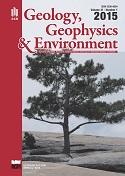Structural and vibrational behaviour of pyromorphite-vanadinite solid solution series
##plugins.themes.bootstrap3.article.main##
Keywords
Abstrakt
Pyromorphite Pb5(PO4)3Cl and vanadinite Pb5(VO4)3Cl belong to the apatite supergroup. They are secondary minerals formed in the oxidation zones of lead ore deposits. Both crystallize in hexagonal symmetry with the space group P63/m (Dong et al. 2002). The crystal structure of these two minerals allows to accommodate both metal cations and anionic complexes. It is the reason, why pyromorphite and vanadinite forms solid solution series. Isovalent replacement of P with V is one of the most common anionic substitution.
Lead apatites are one of the least soluble along apatites group minerals and characterized by high thermal stability (Dong et al. 2002, Flis et al. 2011). Characteristic properties of apatite structure cause that these minerals are successfully used in many fields, especially for the immobilization of toxic waste and lead-contaminated soil (Ma et al. 1993, Chen et al. 1997, Dong et al. 2002, Kim et al. 2005). So far, pyromorphite and mimetite are the most known and used for the immobilization of lead. Pyromorphite and mimetite are isostructural with vanadinite, therefore it has been predicted that this mineral is also important for the environment. Accordingly, the aim of this study was to characterize of the pyromorphite-vanadinite solid solution series. This research present systematic changes in the structure of these minerals.
Pure pyromorphite and vanadinite and minerals with intermediate compositions Pb5(TO4)3Cl, where T = P + V, of various P/V ratios were synthesized from aqueous solutions at 298 K and pH = 3.5. Synthetic solids were analyzed by X-Ray diffraction (XRD), infrared absorption spectroscopy (FTIR) and Raman spectroscopy.
Based on the X-Ray analysis, it was found that synthetic precipitates represent homogeneous phases of pyromorphite and vanadinite, which have intermediate chemical composition. Diffraction peaks of pyromorphite-vanadinite solid solution series were shifted due to replacement of PO4 by VO4. Replacement of PO4 by VO4 anions is causing changes in the structure of apatite and hence these shifts. Unit cell parameters of studied solid solutions show a linear variation.
In the FTIR and Raman spectra of pyromorphite-vanadinite solid solutions series, the
bands which are characteristic for vibrations of P-O bonds of the PO4 tetrahedra as well as vibrations of V-O bonds of the VO4 tetrahedra appeared. Analysis of Mid-IR spectra and Raman spectra also allowed to observe correlation between the band positions and the extent of the anionic substitution among the studied series.
The structure of pyromorphite and vanadinite is generally similar, although they vary in chemical composition. Causes of variability are probably connected with the properties of individual ions.
The project was financed with resources of the National Science Centre, Poland, granted based on decision no. DEC-2013/09/N/ST10/00677.
##plugins.generic.usageStats.downloads##
Bibliografia
Dong Z., White T.J., Wei B. & Laursen K., 2002. Model Apatite Systems for the Stabilization of Toxic Metals: I, Calcium Lead Vanadate. Journal of the American Ceramic Society, 85, 10, 2515-2522.
Flis J., Manecki M. & Bajda T., 2011. Solubility of pyromorphite Pb5(PO4)3Cl-mimetite Pb5(AsO4)3Cl solid solution series. Geochimica et Cosmochimica Acta, 75, 1858–1868.
Kim J.Y., Dong Z. & White T.J., 2005. Model Apatite Systems for the Stabilization of Toxic Metals: II, Cation and Metalloid Substitutions in Chlorapatites. Journal of the American Ceramic Society, 88, 5, 1253–1260.
Ma Q.Y., Traina S.J, Logan T.J. & Ryan J.A., 1993. In Situ Lead Immobilization by Apatite. Environmental Science and Technology, 27, 1803–1810.


